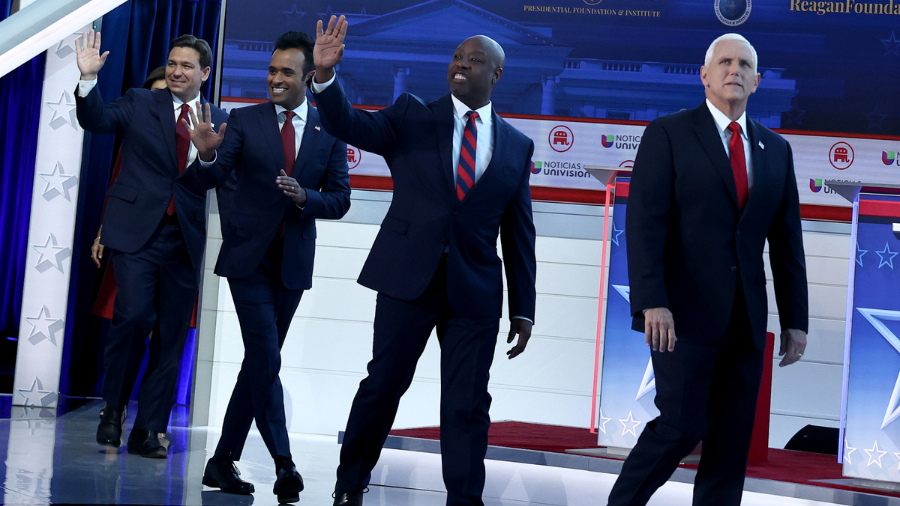Medved: Crucial numbers that Republicans can’t ignore
Oct 25, 2022, 12:36 PM | Updated: Dec 21, 2022, 2:28 pm

This year, polling indicates a likely Republican takeover of the House due to similar factors: The latest Real Clear Politics average shows a 1.6% GOP advantage which, based on recent history and the advantageous apportionment for Republicans, should be more than enough to make Kevin McCarthy the new Speaker. (Photo by Drew Angerer/Getty Images)
(Photo by Drew Angerer/Getty Images)
The mid-term elections will answer two significant questions about the nation’s political present and immediate future.
First, and most obviously, they will decide whether the U.S. will revert to the recent norm of divided government after a brief, turbulent two years of Democratic control of both houses of Congress and the presidency.
Second, the returns this November will help determine whether Donald Trump will maintain his long-term dominance over the Republican Party, or whether the MAGA era should draw to an end, for the sake of the GOP’s survival and success.
In considering both these decision points, Republicans ought to examine crucial numbers from 10 years of recent elections that many party loyalists would prefer to ignore.
Those numbers involve the percentage of the national electorate who, in casting their ballots, want Democrats or Republicans to exercise Congressional control.
More from Michael Medved: Biden’s student loan forgiveness plan fails majority of Americans
Only once in the past decade – during the Obama second term election of 2014 – did a majority of voters support Republican candidates for Congress. Contrary to the common conviction that the leadership of President Trump helped to expand the Republican base, especially among blue collar whites, Congressional elections have shown little or no growth in the overall levels of support for the GOP.
In 2020, when Trump polled 46.9% of the popular vote, it’s hard to argue that his coattails in any way benefited the Congressional nominees who ran alongside him. Actually, GOP House candidates did slightly better than the incumbent president (47.7% of all votes cast) and gained 14 seats due to the demographic concentration of Democratic voters in some of the nation’s most populous urban districts.
This year, polling indicates a likely Republican takeover of the House due to similar factors: The latest Real Clear Politics average shows a 1.6% GOP advantage which, based on recent history and the advantageous apportionment for Republicans, should be more than enough to make Kevin McCarthy the new Speaker.
But little of this optimism depends on the purported, persistent popularity of President Trump. The RCP averages in October showed the former president rated “unfavorably” by a clear majority of voters (54% to 41%), giving him even less support than the struggling Joe Biden (seen unfavorably by a margin of 52% to 44%).
Beyond the obviously imperfect predictions from polling, the actual numbers in recent elections show indisputable disenchantment with the Republican Party in general. Aside from the Democrat’s ability to hold the House and capture both the Senate and White House in 2020, the figures from the last mid-term election in 2018 showed even stronger currents in a Democratic direction.
Despite enthusiastic campaigning by President Trump, the opposition Dems added 41 House seats (far more than likely GOP gains this year) and crushed Republican candidates by an unusually decisive margin (53.4% to 44.8%).
These numbers deserve consideration in view of the common conviction that Trump’s leadership worked magic for the conservative cause, delivering broad-based support in a way that no other leader could have achieved in 2016 and 2020, not to mention in the upcoming races of 2022 and 2024. Yet even in his triumphant campaign against Hillary Clinton, the flamboyant nominee won only 46.1% of the popular vote (less than Mitt Romney’s 47.2% four years before).
Moreover, Trump’s all-important victories in crucial swing states depended largely on more mainstream Senatorial candidates (Ron Johnson in Wisconsin, Pat Toomey in Pennsylvania, Marco Rubio in Florida, John McCain in Arizona, Johnny Isakson in Georgia, and Rob Portman in Ohio) each of whom ran well ahead of the party’s national standard-bearer in their state contests.
Social media platforms brace for midterm elections mayhem
Portman, for instance, outpolled his Democratic opponent by a landslide margin of 22% while Trump carried the Buckeye State by 8%. Rubio won his highly competitive race by 8% while Trump narrowly won Florida by 1%.
This year, those Senate candidates most closely associated with Trump in each of those swing states (Mehmet Oz in Pennsylvania, Blake Masters in Arizona, Herschel Walker in Georgia, and J.D. Vance of Ohio) are precisely those embattled contenders in the greatest danger of losing Republican seats in November and handing the Democrats Senate control.
Of course, each of those Republicans still stands a chance of victory and some pundits and prognosticators persist in predicting a sweeping GOP tidal wave (with a 30-seat gain or more) in the House of Representatives. But even good news on election night shouldn’t prevent an honest, clear-eyed evaluation of Republican struggles in the course of recent years, leading to fresh themes and renewed strategies on behalf of building a durable, conservative electoral majority.
Listen to Michael Medved weekday afternoons from 12 – 3 p.m. on KTTH 770 AM (or HD Radio 97.3 FM HD-Channel 3).














